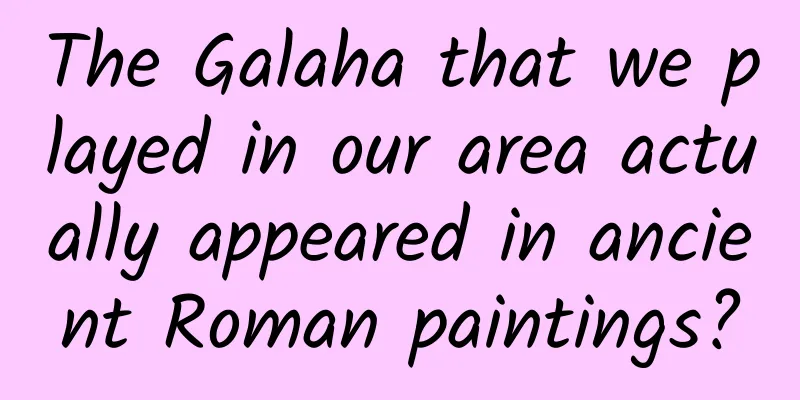The Galaha that we played in our area actually appeared in ancient Roman paintings?

|
In my hometown in Northeast China, there is a toy called "Gala" or "Galaha" (gǎ la hà). Galaha is not a Chinese word, but a transliteration of the hind leg joint bone of cattle, sheep, pigs, etc. in Manchu. This square bone is called talus in anatomy, which grows under the calf and is part of the ankle. In Northeast China, sheep talus is called sheep gala, and pig talus is called pig gala. Four or five of them are a set, and they are toys for throwing and catching reactions. Do you play this game there? | VideoChinaTV / Youtube More than 20 years ago, when old-fashioned board games such as Monopoly were not yet popular, throwing Galaha was a common game on the kang, tables, and beds in Northeast China. In a group of two, the players first threw up a Galaha (usually a sheep Galaha or a plastic imitation), then grabbed as many Galaha as possible on the table or turned them to a specific side, and then caught the fallen piece with the same hand. Although I haven’t played this game for more than ten years, the green, pink, blue and orange candy-like appearance of the plastic Galaha is still vivid in my memory. You can still buy plastic Galaha on Taobao | Screenshot from Taobao I have always thought that the Galaha game is a local product of the Northeast, a byproduct of cooking cattle and sheep in the past, until I saw this ancient Roman picture, I felt like I had traveled through time... Zoom in a little bit... Zoom in a little more... Photo | National Archaeological Museum of Naples In the picture, a woman squats on the ground, with a bone firmly placed on the back of her hand, her palm facing down, and two bones of the same size falling below. The two narrow sides of these flat bones are twisted into an "S" shape, and the two wide sides are one convex and one concave. Isn't this the Galaha of Northeast China? This picture was found in the ancient city of Herculaneum, Italy. The image of five Roman women playing the game of Kalaha was sealed for a long time by the volcanic ash in 79 AD. But if the image is real (and of course it is), why do humans have a special liking for this humble (sheep) bone? When did humans start playing Galaha? After searching for more information, I found that throwing Galaha is almost a worldwide game. It is called "astragaloi" in Greek, "tali" in Latin, "knucklebones" or "hucklebones" in English, and "shagai" in Mongolian. These words are the same as "Galaha" or "Yangguai" in Chinese. These words all refer to the astragalus (plural form) of animals, and even specifically refer to the astragalus of sheep. Sculpture of two women playing the Kalaha, 4th century BC | British Museum According to archaeological discoveries, Galaha as a toy first appeared on the eastern coast of the Mediterranean Sea more than 5,000 years ago. At that time, humans did not have a written history. Later, the game spread northward and was mastered by the ancient Greeks and Romans. The ancient Greek historian Herodotus believed that the game came from the Lydian region (located in Turkey), while Plato said that it was invented by the ancient Egyptians. Sculpture from the 1st century AD, with several Galahas in front of the boy biting someone's thigh | British Museum There are many ways to play the game of Galaha in the Western classical era. The simplest one is to compare the number of Galaha: throw four or five Galaha upwards, and the one who catches the most with the back of his hand wins; or throw Galaha into a small hole or bottle, and the one who throws the most Galaha wins. Another way to play is to compare numbers. The shape and size of Galaha is similar to that of an eraser, except that the four sides at the two ends can stand upright. These four sides are marked with numbers 1, 3, 4, and 6 (the sum of the two opposite sides is 7), so that each throw can count points. Therefore, some people believe that the modern six-sided dice is the product of the evolution of the ancient Galaha game. Each of the four faces of Galaha is different | Reference 8 Based on the numerical value, a set of number combination rules was developed. In a letter written by the ancient Roman Emperor Augustus to Tiberius, it was mentioned that the best throw was not the one with the highest sum of numbers, but the one with four Galaha showing different numbers, which was called "Venus"; if the numbers were all 1, it was the worst throw - called "Canis". This content was quoted by Suetonius, who was born in the 1st century AD, and little is known about other details of the scoring method. How rare is Galaha? The ancient Greek warning "You fool children with astragaloi but men with oaths" may explain how much children like Galaha. In a child's tomb in Antandros (now Turkey), 36 Galaha bones were placed together with other toys. These small cubes were probably the favorites of the children when they were alive. People are naturally not resistant to beautiful small objects, such as beautiful shells and stones. In this regard, sheep astragalus seems to meet the standard. Astragalus is one of the few flat, small block-shaped bones in animals. Among common domesticated animals such as cattle, sheep, horses, and pigs, sheep astragalus is the smallest, which can be held in the hands of children without slipping through the fingers of adults. I still remember that when I was eight or nine years old in my hometown in Northeast China, my grandmother told me to put the Galaha blocks I played with in a cloth bag. At that time, Galaha was sold in sets, and it had to be put in a fixed bag and the drawstring was tightened. In my impression, Galaha bones (although I was playing with plastic imitations at the time) are good things. Galaha has been given many positive and even romantic meanings. In ancient Greece, two friends would keep half of the galaha bone as a reminder of their friendship. These two halves of the galaha were called lispai (λῐ́σπος). Ancient Greek inscription of the messenger god Hermes | Reference 4 In addition to being a token of loyalty, Galaha seems to be considered a medium for communicating with gods. A large number of artificially trimmed talus bones have been unearthed along the Mediterranean coast. Some of them have been polished, some have been burned, and some have been engraved with the names of ancient Greek gods. Thousands of Galaha bones were found in the Korykeion Cave (6th to 3rd century BC) on the island of Crete. These bones may have been thrown into the cave as offerings to the gods, or as a kind of amulet. Some believe that these talus bones came from sacrificial animals, and the priests scattered the Galaha bones in front of the illusions of the gods, interpreting various phenomena or predicting the future through bone divination. The protective function of Galaha is also used in cemeteries. The large number of Galaha bones found in adult cemeteries cannot be explained by toys. In the Varranone cemetery (3rd-2nd century BC) in central Italy, more than 100 Galaha bones were scattered on the side of an adult female body near the tomb entrance, mixed with another common evil-repelling item - iron nails; and in another ancient Greek cemetery, the Cemetery of Contrada Lucifero in southern Italy, a double tomb was found with about 1,400 Galaha bones, covering the remains of two people from head to toe. As for whether these Galaha bones guard the rest of the dead or protect the living from the invasion of the dead, it is unknown. In addition, the anchor blocks found near the Mediterranean and the Black Sea are often engraved with images of Galaha, which may express the desire to land safely. When fortune-telling, the ancient Greeks would throw a set of Galaha bones on the ground and interpret the oracle based on the number of points. This bone fortune-telling is believed to be particularly popular among unmarried women - the best way to tell a marriage is named after the goddess of love, "Venus" (or "Aphrodite"), which may be derived from the popularity of Galaha bone fortune-telling among young women. How popular is the game of Galaha? In order to determine how popular the Galaha game is, I consulted several friends around me about how to play Galaha: Liaoning friend A Throw up two Galahas, grab the two on the ground before they hit the ground, and then catch the falling Galaha (a set of four). Liaoning Buddy B Throw a rubber ball up, grab as many Galahas as possible on the ground before it hits the ground, and then catch the ball (a set of five). Jilin Buddy C Throw a sandbag up, turn the Galaha on the ground to a specific side before it hits the ground, and then catch the sandbag. Gansu partner D Use stones, throw them up, and catch as many as possible with the back of your hand. It is not difficult to find similarities by observing the paintings left over from modern Western times. Detail from the painting "Children's Game", 1560 | Pieter Bruegel the Elder / Kunstmuseum Vienna Oil painting "Les Osselets" (The Galaha Game), 1734 | Jean-Baptiste-Simeon Chardin / Baltimore Museum of Art When American ethnographer Dorothy Howard visited Australia in the 1950s, she found that locals were still playing games with real Galaha bones, even though plastic versions were sold in shops. (In the West, the current toss-and-catch game "Jacks" is considered an evolution of Galaha, with a set of ten parts and a rubber ball, but the gameplay is similar.) Jacks Game | The Children's Museum of Indianapolis In the 1970s, scholars discovered that children in Iran and Turkey were also playing the game of galaha. In Iran, galaha is similar to pinball, and children hit two galaha pieces against each other. The Turkish game is a little more complicated. Players line up the bones and take turns hitting one of the bones in the line with a heavier (sometimes lead-filled) galaha. The winner is determined by which side the galaha flips. The traditional Mongolian game of Galaha involves divination and catapult. The four sides of the Galaha bone are called horse, camel, sheep and goat. The two concave sides of horse and sheep represent good luck, while the two convex sides of camel and goat represent bad luck. The catapult game played with Galaha still appears at the Nadam Festival. So, is the widespread distribution of the Galaha game the result of modern dissemination, or is it an established tradition in different cultures? The answer may be the latter. In 1951, scholar Brian Sutton-Smith compared the games played by Maori children and white children in New Zealand. He believed that before the Europeans arrived in Australia, the locals already had the game of Galaha, which included three main ways of playing. The arrival of Westerners may have only added a fourth new rule. Because the words describing the last one all come from English, while the first three have Maori language counterparts. These ways of playing are: Gameplay 1 After throwing a piece up, catch the thrown (one or several) Galahas with the back of your right hand. Gameplay 2 After throwing up a piece, arrange the other Galaha on the ground with your right hand, such as in a line, circle, square, or diamond shape, and then catch the thrown Galaha. Gameplay 3 After throwing a piece up, grab the Galaha on the ground with your right hand, and then catch the thrown Galaha. Gameplay 4 After throwing a piece up, transfer the Galaha bone on the ground to your left hand with your right hand, and then catch the Galaha with your right hand. ...Does it feel familiar? Sutton-Smith believes that the Maori already had their own galaha game before modern times, after all, it is one of the oldest games in the world. When the Europeans arrived, the traditions shared by the two cultures - such as playing galaha - were strengthened. Now, in museums, you can see galaha unearthed from all over the world, including real galaha bones, as well as metal galaha, glass galaha, ivory galaha, jade galaha, etc. When I recall the plastic galaha in the color of fruit candy when I was a child, I seem to smell the smell of flour on the sheets in my hometown. Perhaps the Galaha bone is the most beloved bone of all, although this enduring love is difficult to explain rationally. Author:vicko238 References [1] Dice & Divination: Playing With Knucklebones. https://hubpages.com/education/Dice-Divination-Playing-with-Knucklebones [2] Knucklebones. http://archaeologicalmuseum.jhu.edu/the-collection/object-stories/archaeology-of-daily-life/childhood/knucklebones/ [3] Game of the Month: Knucklebones. http://www-cs.canisius.edu/~salley/SCA/Games/knucklebones.html [4] Bar-Oz, G. (2012). An inscribed astragalus with a dedication to Hermes. Near Eastern Archeology, 64(4) 211-213. [5] Hombas, VC & Baloglou, CP (2005). Gambling in Greek Antiquity. CHANCE, 18(2), 49–50. Mazzorin, JDG, & Minniti, C. (2013). Ancient use of the knuckle-bone for rituals and gaming piece. Anthropozoologica, 48(2), 371–380. [6] Sutton-Smith, B. (1951). The meeting of Maori and European cultures and its effects upon the unorganized games of Maori children. The Journal of the Polynesian Society, 60(2/3), 93-107. Tahberer, B. (2012). Astragaloi on ancient coins: game pieces or agents of prophecy? The Celator, 26(4), 6-21. |
<<: Skipping breakfast can easily lead to 3 diseases! The first one torments many people...
>>: Why do men with impotence often fart? Clinical research gives the authoritative answer!
Recommend
If you want to become the most scarce operator on the Internet, please follow these ten steps!
In the author's opinion, product operations i...
Retention rate? Several classic methods to keep more users!
An APP and its users will go through four stages:...
If an earthquake strikes, are our houses really safe?
When it comes to earthquakes, everyone must be fa...
What are open links and black links? Things to note when buying open links and black links!
The day before yesterday, when I was chatting wit...
As a new app, you can't miss these free resources
For a new app, you may hope to get some market re...
Remember Dory, the blue fish in Finding Nemo? It really exists
Blue devil fish mainly inhabit the coral reefs of...
With a continuous monthly growth of 50%+, how can brand marketing promotion go from 0 to 1?
The process of brand creation can be mainly divid...
Meizu MX4 Pro first experience: what can you get for spending an extra 700 yuan?
Meizu MX4 Pro is here, it is the second phone lau...
How to improve users’ acceptance of advertising? Here are 7 techniques!
Those great advertisements often come from the bra...
24 tips for stranger social networking. What needs does stranger social networking solve?
Training Outline Opening remarks: Five modules to...
Does the Internet mean low prices? See how this TV brand, which sells for 8,000 yuan, does it
It can be said that low prices have both made the...
Meizu Flyme Developer Salon opens in Beijing to create and grow together
[[139121]] On July 8, 2015, Meizu's "Sta...
Beijing cracks down on ride-hailing services: the straw that breaks the camel's back?
Following Guangzhou and Chengdu, traffic manageme...
Breaking news! First detection in mainland China!
Tianjin detects the Omicron variant of the novel ...
How to accurately target information flow ads? The crowd has chosen it for you, just use it!
In this article, we will learn about people with ...









